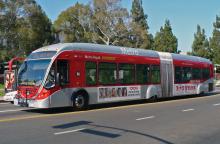Three global organisations have teamed up to launch what they claim is the most comprehensive, public database of bus rapid transit (BRT) systems around the world. The new site, http://BRTdata.org, was created by Embarq, the World Resources Institute’s centre for sustainable transport, and the Across Latitudes and Cultures - Bus Rapid Transit Centre of Excellence (ALC-BRT CoE), in collaboration with the International Energy Agency (IEA).
Three global organisations have teamed up to launch what they claim is the most comprehensive, public database of bus rapid transit (BRT) systems around the world. The new site, %$Linker: External 0 0 0 oLinkExternal BRTdata.org Bus Rapid Transit Data Website false http://brtdata.org/ false false %>, was created by 2091 EMBARQ, the 4722 World Resources Institute’s centre for sustainable transport, and the 4723 Across Latitudes and Cultures - Bus Rapid Transit Centre of Excellence (ALC-BRT CoE), in collaboration with the 4724 International Energy Agency (IEA).
BRT is one of the fastest growing public transport systems. Approximately 134 cities worldwide, from Bogota to Beijing, have implemented BRT systems or priority bus corridors, serving more than 22 million passenger trips daily. It is a mode of public transport that flexibly combines stations, vehicles, services, running ways and intelligent transportation system elements into an integrated system.
“The new website provides reliable and up-to-date data to help researchers, transit agencies, city officials, and NGOs understand and make better decisions to improve BRT and bus corridors in their cities,” said Dario Hidalgo, director of research and practice, Embarq. “This is the first time that all of this publicly available data has been compiled in one place, but there is still more information available. We invite transit agencies and researchers to help us improve the knowledge base by sharing additional data to fill in the gaps.”
The new website allows users to compare BRT systems and bus corridors in all 134 cities in 36 countries. The database includes 95 different indicators on system operations, design and cost, including metrics like the number of passengers per day, commercial speed, and the length of corridors.
BRT is one of the fastest growing public transport systems. Approximately 134 cities worldwide, from Bogota to Beijing, have implemented BRT systems or priority bus corridors, serving more than 22 million passenger trips daily. It is a mode of public transport that flexibly combines stations, vehicles, services, running ways and intelligent transportation system elements into an integrated system.
“The new website provides reliable and up-to-date data to help researchers, transit agencies, city officials, and NGOs understand and make better decisions to improve BRT and bus corridors in their cities,” said Dario Hidalgo, director of research and practice, Embarq. “This is the first time that all of this publicly available data has been compiled in one place, but there is still more information available. We invite transit agencies and researchers to help us improve the knowledge base by sharing additional data to fill in the gaps.”
The new website allows users to compare BRT systems and bus corridors in all 134 cities in 36 countries. The database includes 95 different indicators on system operations, design and cost, including metrics like the number of passengers per day, commercial speed, and the length of corridors.









